Smart Heritage Practice and Its Characteristics Based on Architectural Heritage Conservation—A Case Study of the Management Platform of the Shanghai Federation of Literary and Art Circles China
Abstract
:1. Introduction
2. Materials and Methods
2.1. Conceptual Foundation and Relevant Developments
2.1.1. Architectural Heritage Conservation in the Digital and Smart Contexts
2.1.2. Platform Developments Associated with Smart Heritage
2.1.3. Relevant Developments in China
2.2. Case Study—The Management Platform of the Shanghai Federation of Literary and Art Circles (SFLAC), China
2.3. Methodology
2.3.1. Data Collection
2.3.2. Data Analysis
3. Results
3.1. Smart Heritage Development Based on Implmentation of Initiatives
3.2. Smart Heritage Development Based on Integration of Digital Mechanisms
3.3. Smart Heritage Development Based on Digital Applications
3.4. Smart Heritage Development Based on Potential Optimisations
4. Discussion: Characteristics Based on the SFLAC Platform for Smart Heritage
Smartness in the heritage discourse should have the ability to evolve, namely smart heritage should be able to perceive, optimise and innovate.(Interviews with the author in 2022.)
5. Conclusions
- (1)
- The development of policies, such as OBOA and TAD, standards, and guidelines for heritage digitalisation and smartness and establishment of particular platform standards with pilot projects for practice. A positive policy context is crucial to achieve smartness. On the contrary, the practice of smart heritage implements national and local strategies, resulting in effective urban smart updates;
- (2)
- Digitalisation for starting the practice of pilot projects: well-rounded information collection, including traditional archives digitalisation and on-site surveying, digital modelling, sensor placement, etc., should all be included;
- (3)
- The development of a smart platform for heritage data storage and demonstration, integrating conservation personnel (e.g., technicians, professionals, etc.) and supportive technologies to satisfy different requirements;
- (4)
- Further applications of digital archives and the platform, including heritage conservation, safety and stability monitoring, conservation staff (e.g., on-site inspectors, platform supervisors, etc.) management, and coordination of different heritage conservation authorities;
- (5)
- Future optimisations are required in the proposal of heritage smartness. It can start with technologies and platform connections and carry on to personnel cultivation.
Author Contributions
Funding
Institutional Review Board Statement
Informed Consent Statement
Data Availability Statement
Acknowledgments
Conflicts of Interest
References
- Petzet, M. Principles of Preservation: An Introduction to the International Charters for Conservation and Restoration 40 Years after the Venice Charter; ICOMOS: München, Germany, 2004. [Google Scholar]
- Brusaporci, S. Digital Innovations in Architectural Heritage Conservation: Emerging Research and Opportunities: Emerging Research and Opportunities; IGI Global: Hershey, PA, USA, 2017. [Google Scholar]
- Lopes, R.O.; Malik, O.A.; Kumpoh, A.A.Z.A.; Keasberry, C.; Hong, O.W.; Lee, S.C.W.; Liu, Y. Exploring Digital Architectural Heritage in Brunei Darussalam: Towards Heritage Safeguarding, Smart Tourism, and Interactive Education. In Proceedings of the 2019 IEEE Fifth International Conference on Multimedia Big Data (BigMM), Singapore, 11–13 September 2019. [Google Scholar]
- Siountri, K.; Vergados, D.D. Smart cultural heritage in digital cities. J. Sust. Dev. Cult. Tradit. SDCT-J 2018, 1b, 23–32. [Google Scholar]
- Song, H.; Selim, G. Smart Heritage for Urban Sustainability: A Review of Current Definitions and Future Developments. J. Contemp. Urban Aff. 2022, 6, 175–192. [Google Scholar] [CrossRef]
- Apollonio, F.I.; Gaiani, M.; Bertacchi, S. Managing cultural heritage with integrated services platform. ISPRS Ann. Photogramm. Remote Sens. Spat. Inf. Sci. 2019, 42, 91–98. [Google Scholar] [CrossRef]
- Opoku, A.; Akotia, J. Urban regeneration for sustainable development. Constr. Econ. Build. 2020, 20, 1–5. [Google Scholar]
- Opoku, A. SDG2030: A sustainable built environment’s role in achieving the post-2015 United Nations Sustainable Development Goals. In Proceedings of the 32nd Annual ARCOM Conference, Manchester, UK, 5–7 September 2016; Association of Researchers in Construction Management: Manchester, UK, 2016. [Google Scholar]
- Ann, B.; Jonathan, P.B. Smart Cities and Cultural Heritage—A Review of Developments and Future Opportunities. In Proceedings of the Electronic Visualisation and the Arts (EVA 2017), London, UK, 11–13 July 2017; BCS, The Chartered Institute for IT: London, UK, 2017. [Google Scholar]
- Trillo, C.; Aburamadan, R.; Makore, B.C.N.; Udeaja, C.; Moustaka, A.; Gyau Baffour Awuah, K.; Patel, D.A.; Mansuri, L.E. Towards smart planning conservation of heritage cities: Digital technologies and heritage conservation planning. In Proceedings of the International Conference on Human-Computer Interaction, Copenhagen, Denmark, 24–29 July 2021; Springer: Cham, Switzerland, 2021. [Google Scholar]
- Abdelmonem, M.G.; Selim, G.; Mushatat, S. Virtual Platforms for Heritage Preservation in the Middle East: The Case of Medieval Cairo. Archnet-IJAR Int. J. Archit. Res. 2017, 11, 28–41. [Google Scholar] [CrossRef]
- Selim, G.; Jamhawi, M.; Holland, A.; Ma’bdeh, S. Digitizing Heritage as an Integrated Sustainable Tool for Informative Interpretation of the Past: The Case of Umm Qais, Jordan. Tradit. Dwell. Settl. Rev. 2021, 32, 16. [Google Scholar]
- Allam, Z. Identified priorities for smart urban regeneration: Focus group findings from the city of Port Louis, Mauritius. J. Urban Regen. Renew. 2019, 12, 376–389. [Google Scholar]
- Allam, Z.; Newman, P. Redefining the smart city: Culture, metabolism and governance. Smart Cities 2018, 1, 4–25. [Google Scholar] [CrossRef]
- Garau, C. From Territory to Smartphone: Smart Fruition of Cultural Heritage for Dynamic Tourism Development. Plan. Pract. Res. 2014, 29, 238–255. [Google Scholar] [CrossRef]
- Zheng, S. Reflections on architectural heritage conservation in Shanghai. Built Herit. 2017, 1, 1–13. [Google Scholar] [CrossRef]
- Zhu, G. China’s architectural heritage conservation movement. Front. Archit. Res. 2012, 1, 10–22. [Google Scholar] [CrossRef]
- Roca, P.; Lourenc, P.B.; Gaetani, A. Historic Construction and Conservation: Materials, Systems and Damage; Routledge: London, UK, 2019. [Google Scholar]
- Qiu, J.; Li, J.; Sun, H. Innovative and applied research on big data platforms of smart heritage. ISPRS Ann. Photogramm. Remote Sens. Spat. Inf. Sci. 2015, 2, 257–261. [Google Scholar] [CrossRef]
- Yilmaz, H.M.; Yakar, M.; Gulec, S.A.; Dulgerler, O.N. Importance of digital close-range photogrammetry in documentation of cultural heritage. J. Cult. Herit. 2007, 8, 428–433. [Google Scholar] [CrossRef]
- Al-kheder, S.; Al-shawabkeh, Y.; Haala, N. Developing a documentation system for desert palaces in Jordan using 3D laser scanning and digital photogrammetry. J. Archaeol. Sci. 2009, 36, 537–546. [Google Scholar] [CrossRef]
- Moustakas, K.; Tzovaras, D. Virtual Simulation of Cultural Heritage Works Using Haptic Interaction; Springer: Berlin/Heidelberg, Germany, 2010. [Google Scholar]
- Albourae, A.T.; Armenakis, C.; Kyan, M. Architectural Heritage Visualization Using Interactive Technologies; Copernicus GmbH: Gottingen, Germany, 2017. [Google Scholar]
- Murphy, M.; McGovern, E.; Pavia, S. Historic building information modelling (HBIM). Struct. Surv. 2009, 27, 311–327. [Google Scholar] [CrossRef]
- Del Giudice, M.; Osello, A. Bim for Cultural Heritage. Int. Arch. Photogramm. Remote Sens. Spat. Inf. Sci. 2013, XL-5/W2, 225–229. [Google Scholar] [CrossRef]
- López, F.J.; Lerones, P.M.; Llamas, J.; Gómez-García-Bermejo, J.; Zalama, E. A Framework for Using Point Cloud Data of Heritage Buildings Toward Geometry Modeling in A BIM Context: A Case Study on Santa Maria La Real De Mave Church. Int. J. Archit. Herit. 2017, 11, 965–986. [Google Scholar] [CrossRef]
- Pocobelli, D.P.; Boehm, J.; Bryan, P.; Still, J.; Grau-Bové, J. BIM for heritage science: A review. Herit. Sci. 2018, 6, 30. [Google Scholar] [CrossRef]
- Martínez-Carricondo, P.; Carvajal-Ramírez, F.; Yero-Paneque, L.; Agüera-Vega, F. Combination of nadiral and oblique UAV photogrammetry and HBIM for the virtual reconstruction of cultural heritage. Case study of Cortijo del Fraile in Níjar, Almería (Spain). Build. Res. Inf. Int. J. Res. Dev. Demonstr. 2020, 48, 140–159. [Google Scholar] [CrossRef]
- Campobello, G.; Altadonna, A.; Todesco, F.; Donato, N. IoT-MHECHA: A new IoT architecture for Monitoring Health and Environmental parameters in Cultural Heritage and Archaeological sites. In Proceedings of the 2020 IMEKO TC-4 International Conference on Metrology for Archaeology and Cultural Heritage, Trento, Italy, 22–24 October 2020. [Google Scholar]
- Barsocchi, P.; Bartoli, G.; Betti, M.; Girardi, M.; Mammolito, S.; Pellegrini, D.; Zini, G. Wireless sensor networks for continuous structural health monitoring of historic masonry towers. Int. J. Archit. Herit. 2021, 15, 22–44. [Google Scholar] [CrossRef]
- Lerario, A.; Varasano, A. An IoT Smart Infrastructure for S. Domenico Church in Matera’s “Sassi”: A Multiscale Perspective to Built Heritage Conservation. Sustainability 2020, 12, 6553. [Google Scholar] [CrossRef]
- Ignacio San Jose, I.; Martinez, J.; Alvarez, N.; Fernandez, J.J.; Delgado, F.; Martinez, R.; Puche, J.C.; Finat, J. An open source software platform for visualizing and teaching conservation tasks in architectural heritage environments. Int. Arch. Photogramm. Remote Sens. Spat. Inf. Sci. 2018, XL-5/W2, 367–372. [Google Scholar] [CrossRef]
- Koukopoulos, Z.; Koukopoulos, D.; Jung, J.J. A trustworthy multimedia participatory platform for cultural heritage management in smart city environments. Multimed. Tools Appl. 2017, 76, 25943–25981. [Google Scholar] [CrossRef]
- Selim, G.; Jamhawi, M.; Abdelmonem, M.G.; Ma’bdeh, S.; Holland, A. The Virtual Living Museum: Integrating the Multi-Layered Histories and Cultural Practices of Gadara’s Archaeology in Umm Qais, Jordan. Sustainability 2022, 14, 6721. [Google Scholar] [CrossRef]
- De Fino, M.; Ceppi, C.; Fatiguso, F. Virtual tours and informational models for improving territorial attractiveness and the smart management of architectural heritage: The 3d-impact project. Int. Arch. Photogramm. Remote Sens. Spat. Inf. Sci. ISPRS Arch. 2020, 54, 473–480. [Google Scholar] [CrossRef]
- Wang, B.; Dai, L.; Liao, B. System Architecture Design of a Multimedia Platform to Increase Awareness of Cultural Heritage: A Case Study of Sustainable Cultural Heritage. Sustainability 2023, 15, 2504. [Google Scholar] [CrossRef]
- Palomar, I.J.; Valldecabres, J.L.G.; Tzortzopoulos, P.; Pellicer, E. An online platform to unify and synchronise heritage architecture information. Autom. Constr. 2020, 110, 103008. [Google Scholar] [CrossRef]
- Fadli, F.; AlSaeed, M. Digitizing vanishing architectural heritage; The design and development of Qatar historic buildings information modeling [Q-HBIM] platform. Sustainability 2019, 11, 2501. [Google Scholar] [CrossRef]
- Artopoulos, G.; Fokaides, P.; Lysandrou, V.; Deligiorgi, M.; Sabatakos, P.; Agapiou, A. Data-Driven Multi-Scale Study of Historic Urban Environments by Accessing Earth Observation and Non-Destructive Testing Information via an HBIM-Supported Platform. Int. J. Archit. Herit. 2023, 1–20, ahead-of-print. [Google Scholar] [CrossRef]
- Li, Y.; Zhao, L.; Chen, Y.; Zhang, N.; Fan, H.; Zhang, Z. 3D LiDAR and multi-technology collaboration for preservation of built heritage in China: A review. Int. J. Appl. Earth Obs. Geoinf. 2023, 116, 103156. [Google Scholar] [CrossRef]
- Yang, C.; Han, F.; Wu, H.; Chen, Z. Heritage landscape information model (hlim): Towards a contextualised framework for digital landscape conservation in China. Int. Arch. Photogramm. Remote Sens. Spat. Inf. Sci.-ISPRS Arch. 2019, 42, 1221–1227. [Google Scholar] [CrossRef]
- Fang, J.; Zhang, Y.; Zhang, Y.; Guo, H.; Sun, Z. High-Definition Survey of Architectural Heritage Fusing Multisensors—The Case of Beamless Hall at Linggu Temple in Nanjing, China. Sensors 2022, 22, 3369. [Google Scholar] [CrossRef] [PubMed]
- Zhang, X.; Zhi, Y.; Xu, J.; Han, L. Digital Protection and Utilization of Architectural Heritage Using Knowledge Visualization. Buildings 2022, 12, 1604. [Google Scholar] [CrossRef]
- GZPI, Guangzhou Urban Planning Survey and Design Institute. Guangzhou Historic Buildings Intelligent Care and Management Digital Platform; Guangdong Provincial Department of Housing and Urban Rural Development: Guangzhou, China, 2023. [Google Scholar]
- Chen, Y.; Wu, Y.; Sun, X.; Ali, N.; Zhou, Q. Digital Documentation and Conservation of Architectural Heritage Information: An Application in Modern Chinese Architecture. Sustainability 2023, 15, 7276. [Google Scholar] [CrossRef]
- East China Architectural Design & Research Institute. Dialogue between the Old and the New: Preservation and Renewal of the Historic Building of Shanghai Federation of Literary and Art Circles. Available online: https://mp.weixin.qq.com/s/vqw4ij5dKUOBYnegmKDR_A (accessed on 12 January 2022).
- Shanghai Historical Building Protection Administration Center. [Magnolia Special] Record of the Restoration Project of the Old Building of Federation of Literary and Art Circles at No. 238 West Yan’an Road (above). Available online: https://mp.weixin.qq.com/s/3zt_zyNI8n7CybuYC6_S6Q (accessed on 30 January 2022).
- Regulations on the Protection of Shanghai Historic Areas and Excellent Historic Buildings; Shanghai Municipal Housing Authority: Shanghai, China, 2020; Shanghai Government Services Website. Available online: https://fgj.sh.gov.cn/yxlsjz/20200414/4e20b42c7b3541cdac34bc12a841ce2a.html (accessed on 30 January 2022).
- Lanka, E.; Lanka, S.; Rostron, A.; Singh, P. Why We Need Qualitative Research in Management Studies. Rev. Adm. Contemp. 2021, 25, e200297. [Google Scholar] [CrossRef]
- Chen, H. Shanghai’s “One Network Unified Management” at the Digital China Construction Summit. 2021. Available online: https://www.chinanews.com.cn/gn/2021/04-26/9464725.shtml (accessed on 20 February 2022).
- XINHUANET. Making Cities Smarter and Wiser—General Secretary Xi Jinping’s Visit to Zhejiang Provides an Important Guideline for Promoting the Modernisation of Urban Governance System and Governance Capacity. Beijing, China. Xinhua News Agency. 2020. Available online: http://www.xinhuanet.com/politics/2020-04/04/c_1125814356.htm (accessed on 20 February 2022).
- Xinmin Evening News. Shanghai Urban Renewal Report ①|Comprehensive Renovation of Qishan Village in the Yuyuan Road Historic District Shanghai, China, 2023; SOHU. Available online: https://www.sohu.com/a/684684470_121286085 (accessed on 24 September 2023).
- Huili, X. This Is How We Understand the Relationship between “One Network Unified Management” and Data Elements in Shanghai. Shanghai, China, 2023; SOHU. Available online: https://www.sohu.com/a/427486082_657456 (accessed on 20 February 2022).
- Website on Architectural Conservation. The Compilation of “One Building One Archive” for Excellent Historic Buildings in Four Districts Passed the Expert Acceptance. Shanghai, China. 2018. Available online: http://www.aibaohu.com/ShowArticle.aspx?id=132 (accessed on 20 February 2022).
- Castells, M. Space of Flows, Space of Places: Materials for a Theory of Urbanism in the Information Age, in the City Reader; Routledge: London, UK, 2020; pp. 240–251. [Google Scholar]
- Bibri, S.E.; Krogstie, J. The core enabling technologies of big data analytics and context-aware computing for smart sustainable cities: A review and synthesis. J. Big Data 2017, 4, 38. [Google Scholar] [CrossRef]
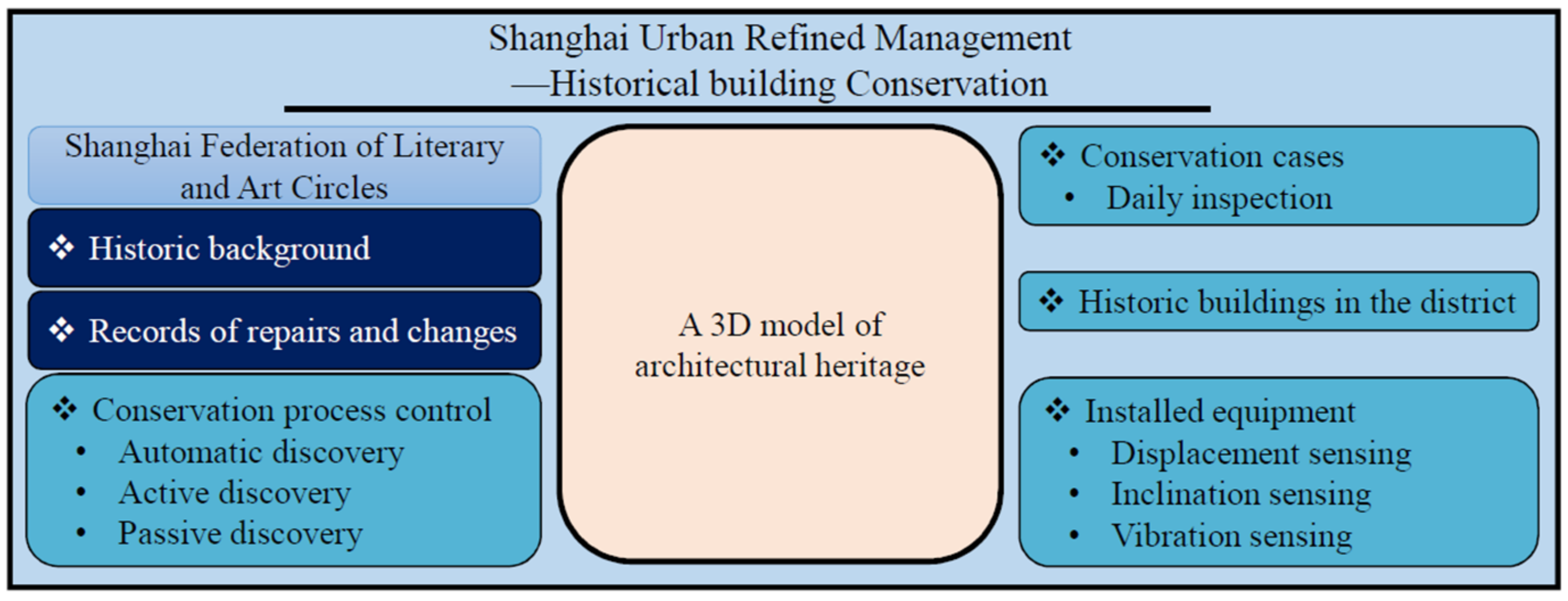
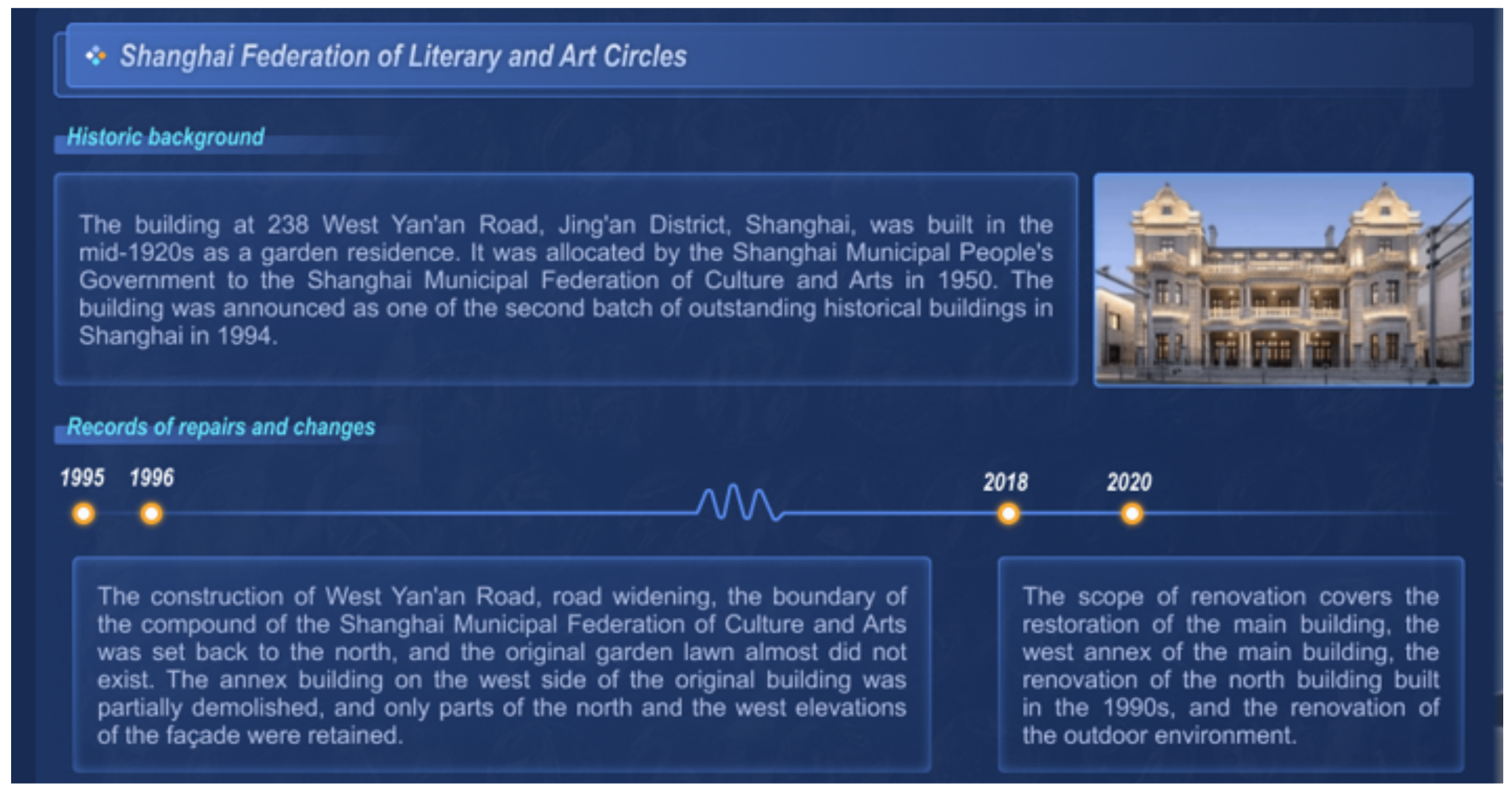
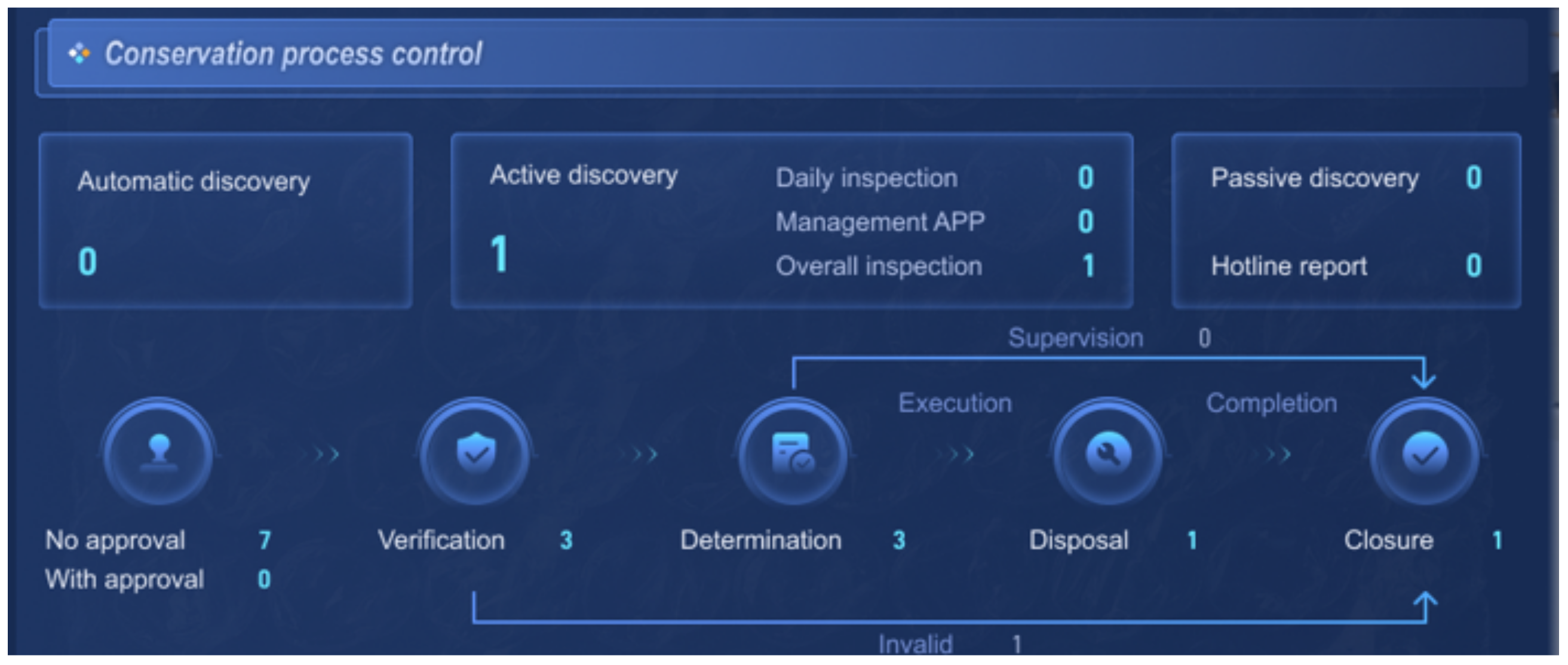
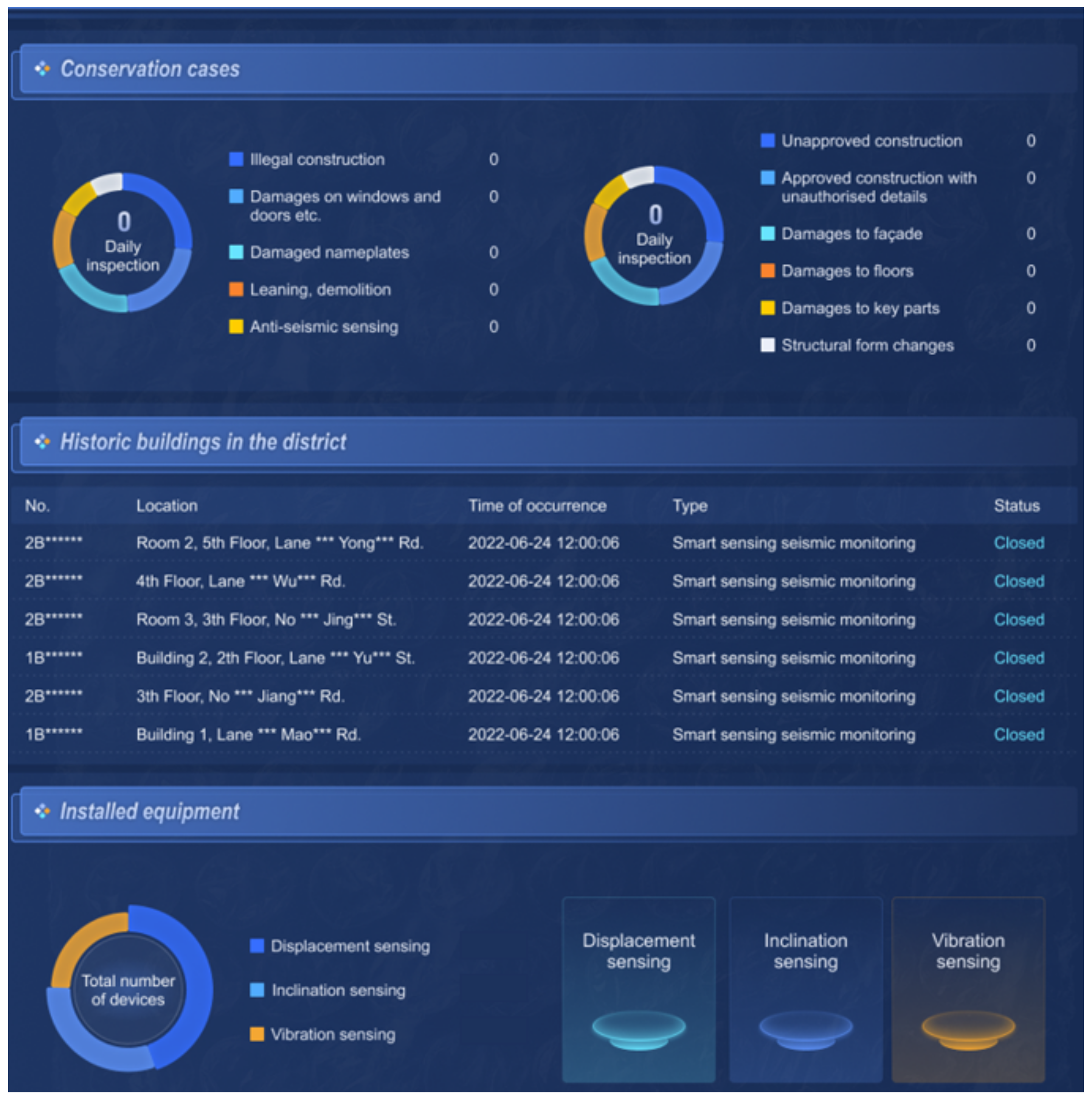
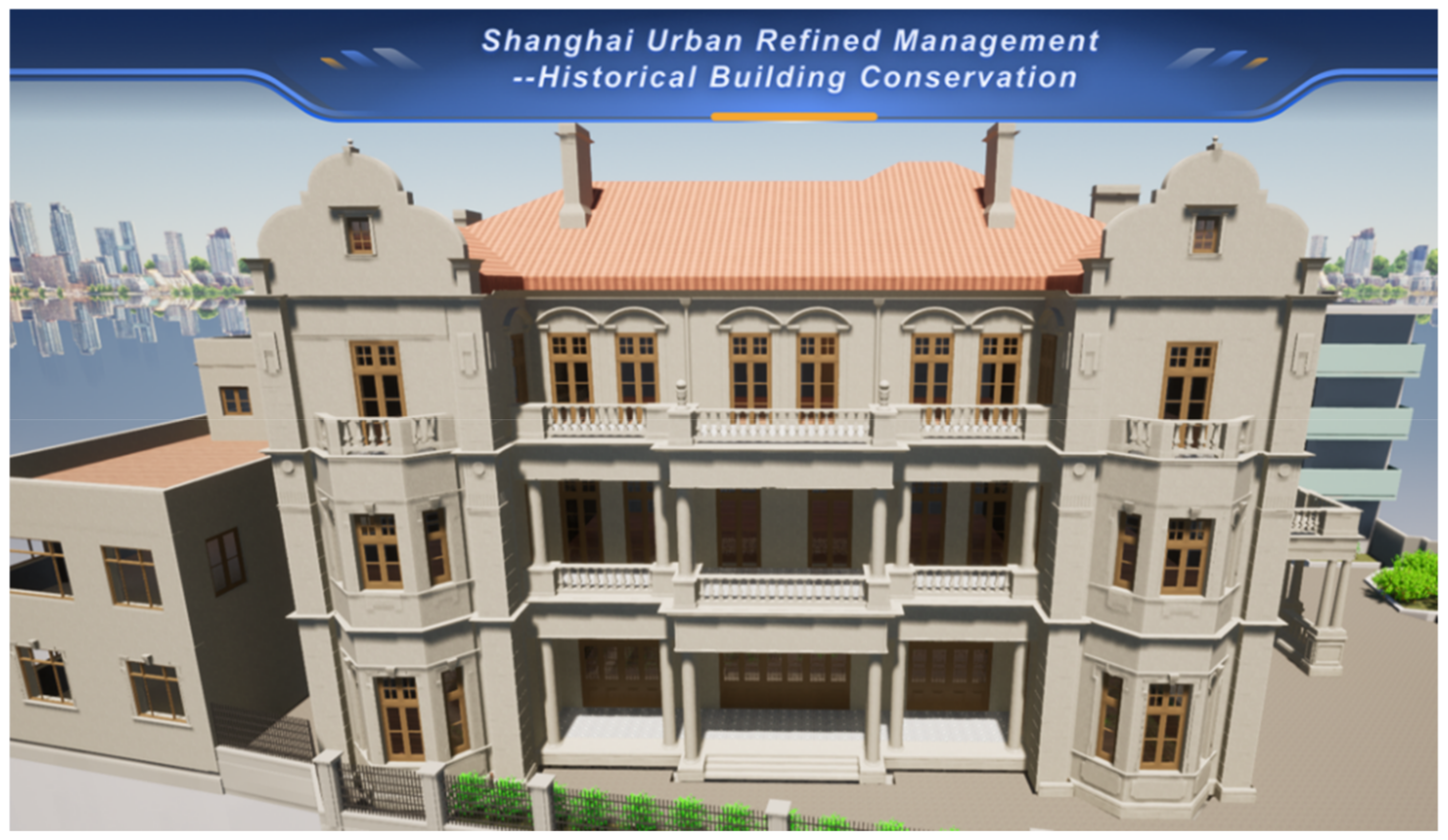
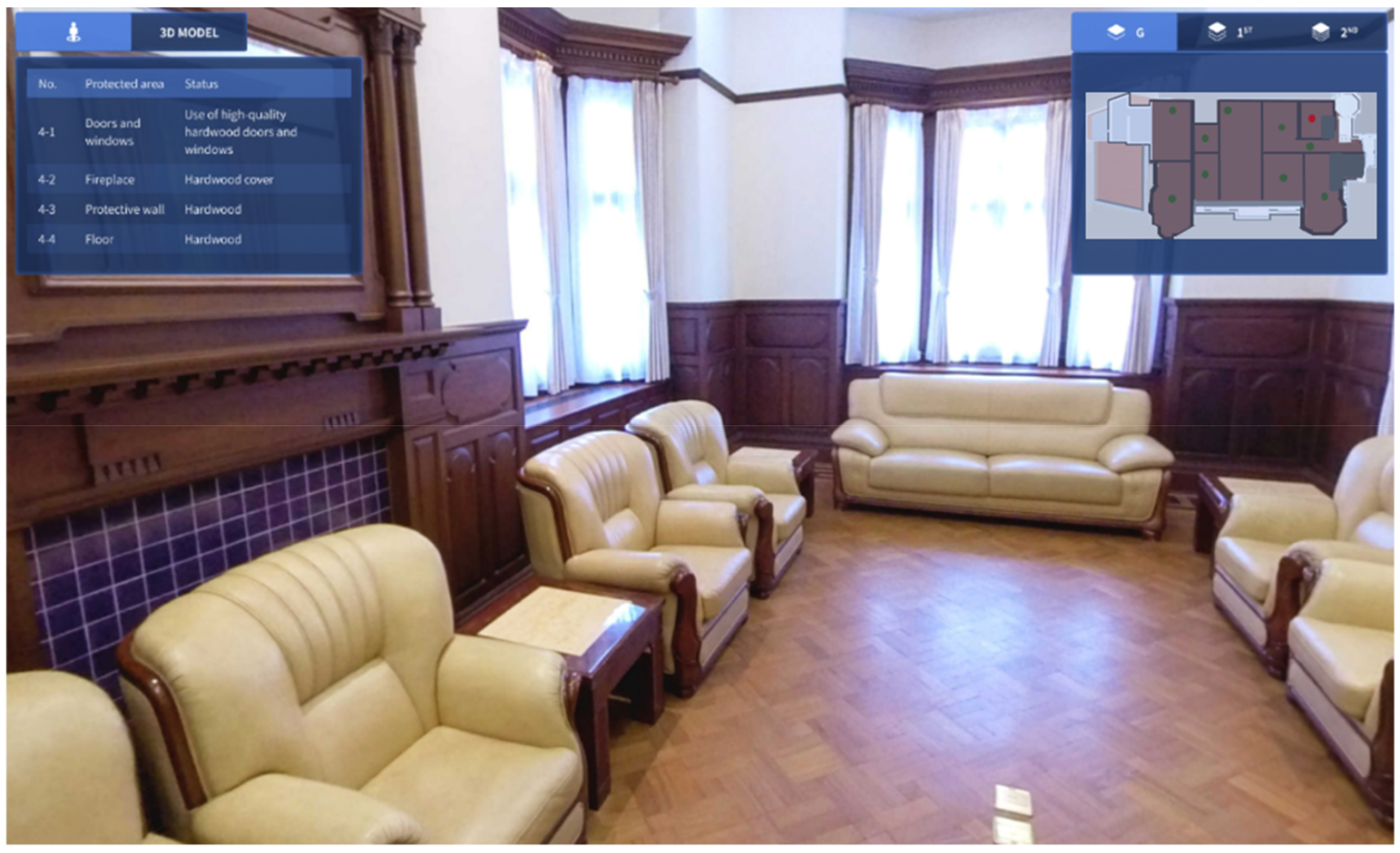


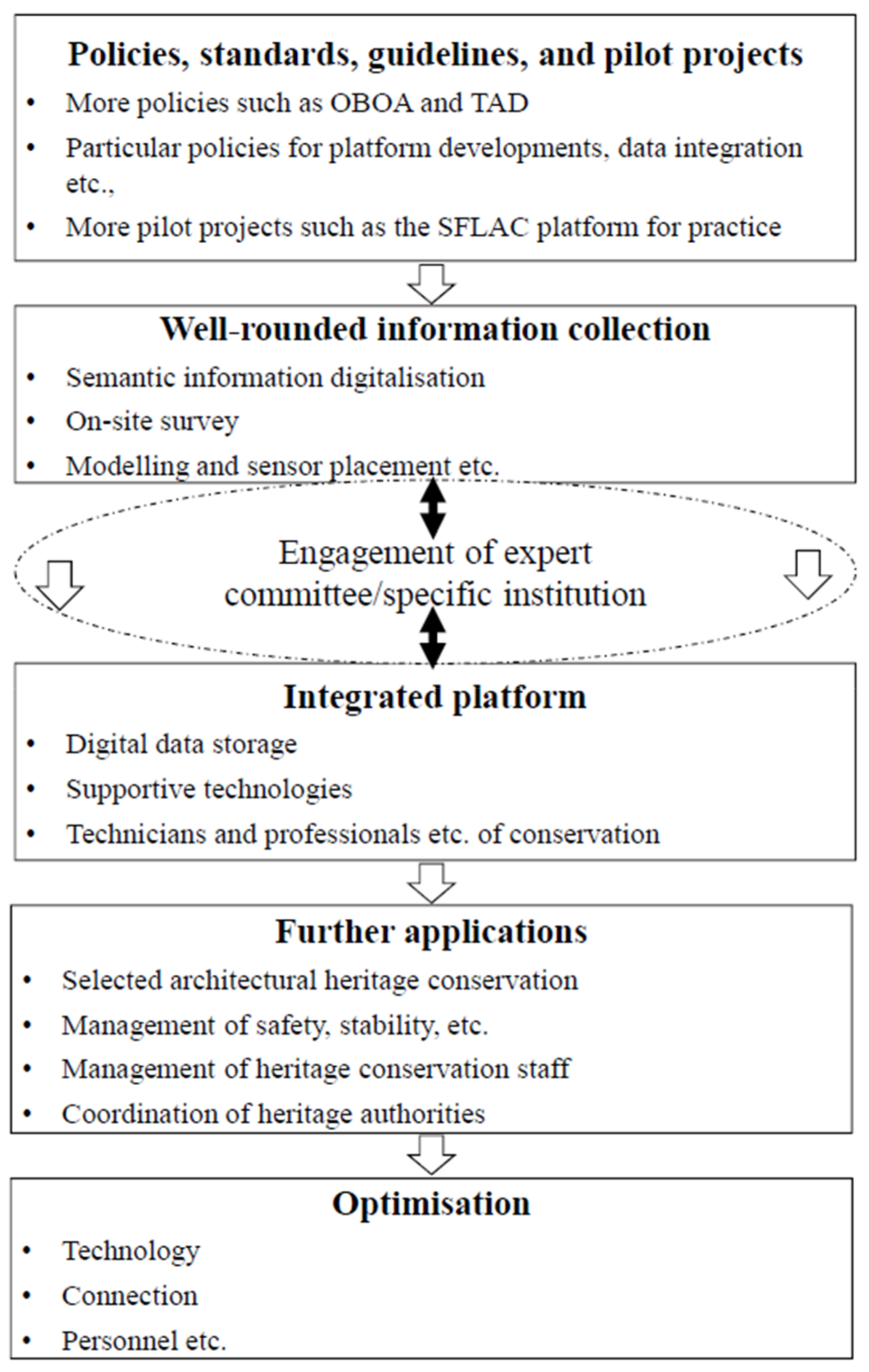
| No. | Code | Roles in Relevant Areas | Work Experience |
|---|---|---|---|
| 1 | C1.S | BIM engineer | 10+ years |
| 2 | C2.S | Consultant (participated to develop the platform) | 10+ years |
| 3 | C3.S | Engineer (participated to develop the platform) | 10+ years |
| 4 | C4.S | Consultant (participated to develop the platform) | 5+ years |
| 5 | C5.S | Architect | 5+ years |
| 6 | C6.S | Consultant in digital transformation | 5+ years |
| 7 | C7.S | Engineer in architectural heritage conservation | 10+ years |
| 8 | C8.S | Consultant in smart building | 2+ years |
| 9 | C9.S | Consultant in smart building | 10+ years |
| 10 | M1.S | Director in data management (participated to develop the platform) | 10+ years |
| 11 | M2.S | Director in smart building | 10+ years |
| 12 | M3.S | Director in heritage conservation (participated to develop the platform) | 10+ years |
| Phase | Output |
|---|---|
| Literature review |
|
| Analysis |
|
| Factors from Initiatives Relevant to Smart Heritage | ||
|---|---|---|
| Overall | Techniques | Management & Service |
| Terminology: i.e., smart heritage | ICT, IoT, BIM, etc., and platform | Digitalisation, inspection, and supervision |
| Smart Heritage Practice Considerations | |
|---|---|
| Short term | To address urgent problems and requirements of architectural heritage |
| Medium term | To develop services benefiting the convenience, efficiency, and integrity of heritage conservation and management and use in historical and cultural areas |
| Long term | Considerations and optimisations corresponding to urban smartness, as well as continuation of culture and history |
Disclaimer/Publisher’s Note: The statements, opinions and data contained in all publications are solely those of the individual author(s) and contributor(s) and not of MDPI and/or the editor(s). MDPI and/or the editor(s) disclaim responsibility for any injury to people or property resulting from any ideas, methods, instructions or products referred to in the content. |
© 2023 by the authors. Licensee MDPI, Basel, Switzerland. This article is an open access article distributed under the terms and conditions of the Creative Commons Attribution (CC BY) license (https://creativecommons.org/licenses/by/4.0/).
Share and Cite
Song, H.; Selim, G.; Gao, Y. Smart Heritage Practice and Its Characteristics Based on Architectural Heritage Conservation—A Case Study of the Management Platform of the Shanghai Federation of Literary and Art Circles China. Sustainability 2023, 15, 16559. https://doi.org/10.3390/su152416559
Song H, Selim G, Gao Y. Smart Heritage Practice and Its Characteristics Based on Architectural Heritage Conservation—A Case Study of the Management Platform of the Shanghai Federation of Literary and Art Circles China. Sustainability. 2023; 15(24):16559. https://doi.org/10.3390/su152416559
Chicago/Turabian StyleSong, Heng, Gehan Selim, and Yun Gao. 2023. "Smart Heritage Practice and Its Characteristics Based on Architectural Heritage Conservation—A Case Study of the Management Platform of the Shanghai Federation of Literary and Art Circles China" Sustainability 15, no. 24: 16559. https://doi.org/10.3390/su152416559
APA StyleSong, H., Selim, G., & Gao, Y. (2023). Smart Heritage Practice and Its Characteristics Based on Architectural Heritage Conservation—A Case Study of the Management Platform of the Shanghai Federation of Literary and Art Circles China. Sustainability, 15(24), 16559. https://doi.org/10.3390/su152416559







